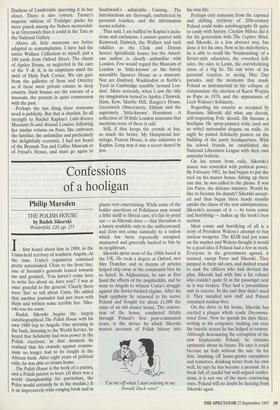Tread safely into the little-known
Simon Jenkins
LITTLE-KNOWN MUSEUMS IN AND AROUND LONDON by Rachel Kaplan Abrams, £13.95, pp. 215 There is an upstairs room in an old museum in Hampstead from which I have London at my feet. The view is incompara- ble. Downstairs a student practises on a spinet. From the garden rises a matching chorus of birdsong. It is one of London's most peaceful spots, a public place so private it might be made for one.
The little museums of London are so much more enjoyable than the big ones. The British Museum, the National Gallery and the Tate may have firepower but they are heavy-duty slogs. However much I insist on doing 'just one room', hours can pass in aimless perambulation as aching feet are jostled by bored, uncomprehending crowds. Big museums are inhuman places, collages of great works projected on a monumental screen. They are for specialists and coach parties.
Small is beautiful. When in New York I go to the Frick, in Washington to the Phillips, in Paris to the Rodin. In London I plead with visitors (and natives) to go off- centre. There are Old Masters aplenty in Dulwich and Kenwood, Hampton Court and Greenwich. More important, there is a manageable architecture and sense of history. At Ham we can imagine the Duchess of Lauderdale queening it in her closet. There is also context. Turner's majestic tableau of Trafalgar packs far more punch among the Nelson memorabil- ia at Greenwich than it could in the Tate or the National Gallery.
Above all, little museums are better adapted to contemplation. I have had the entire Wallace Collection to myself, just a 100 yards from Oxford Street. The charm of Apsley House, so neglected in the care of the V & A, is its emptiness amid the swirl of Hyde Park Corner. We can gaze from the galleries of Syon and Osterley as if these were private estates in deep country. Such houses are the essence of a museum, the present in quiet communion with the past. Perhaps the last thing these museums need is publicity. But that is churlish. So all strength to Rachel Kaplan's Little-Known Museums In and Around London, following her similar volume on Paris. She embraces the familiar, the unfamiliar and particularly the delightfully eccentric. I had not heard of the Bramah Tea and Coffee Museum or of Freud's House, and must go again to Southwark's admirable Cuming. The introductions are thorough, uncluttered by personal touches, and the information seems reliable.
That said, I am baffled by Kaplan's inclu- sions and exclusions. I cannot quarrel with Kenwood, Dulwich, the Wallace and such oddities as the Clink and Dennis Severs' Spitalfields house; but the Ameri- can author is clearly unfamiliar with London. Few would regard the Museum of London as little-known' or the barely accessible Spencer House as a museum. Nor are Duxford, Waddesdon or Kettle's Yard in Cambridge sensibly 'around Lon- don'. More seriously, when I saw the title my imagination turned to Apsley, Chiswick, Ham, Kew, Marble Hill, Ranger's House, Greenwich Observatory, Eltham and the supremely 'little-known' Horniman. A collection of 30 little London museums that mentions none of these is odd.
Still, if that keeps the crowds at bay, so much the better. My Hampstead her- mitage, Fenton House, is also unknown to Kaplan. Long may it stay a secret shared by few.











































































 Previous page
Previous page